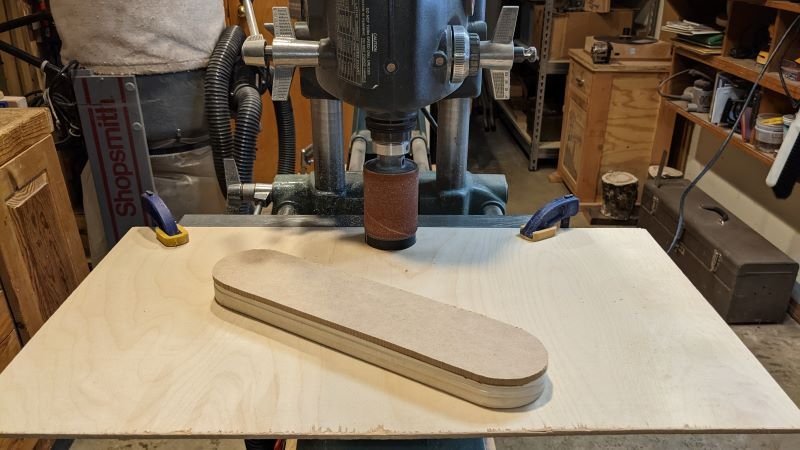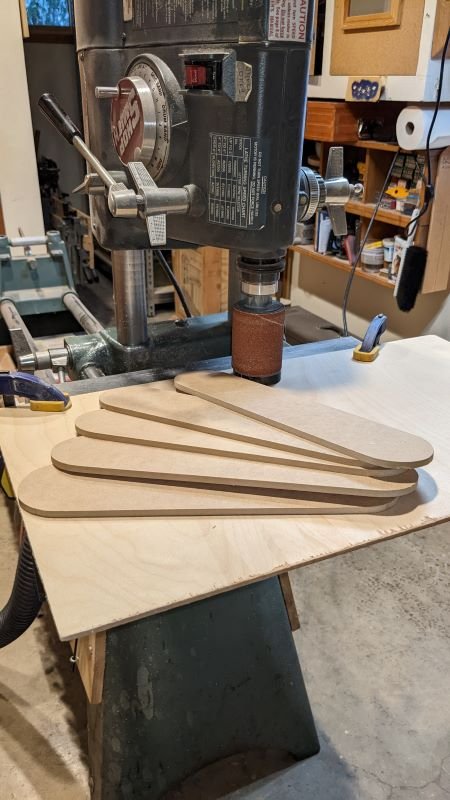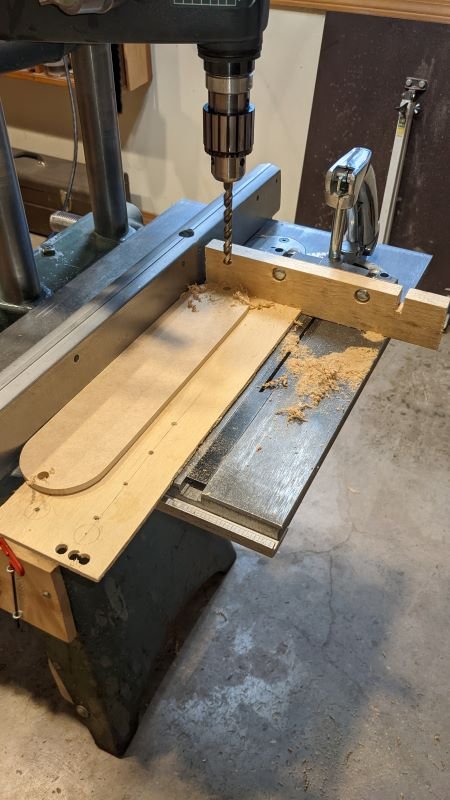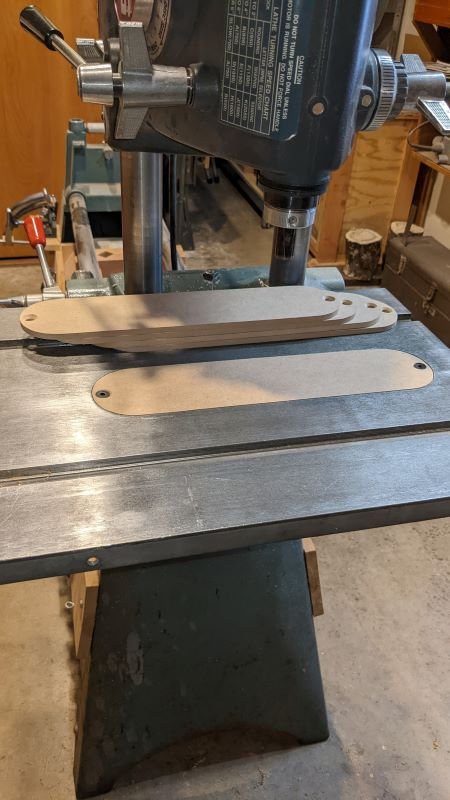Page 6 of 7
Re: ZCI material
Posted: Tue Dec 10, 2024 12:18 pm
by RFGuy
DLB wrote: ↑Tue Dec 10, 2024 10:53 am
Possibly unique to mine, I found the Model 500 style fence (mine was a Greenie) much fussier to set accurately than a 520. This was true whether I was using a measuring device or a spacer device of whatever type. It was simply harder to precisely maintain fence position while locking due to a) a lighter fence; and b) the rotational force needed to lock it in place. This is what led me to embrace the quill fine adjust method.
- David
David,
Thanks. Yeah, I had perhaps a similar experience with my 510 fence to what you describe on your 500 one, but my 520 fence is much different. I know there can be value in using something like the quill index, or a micro-adjust on a TS fence to sneak up on a cut, so to speak. This isn't always needed, but for certain applications it can be real handy. It seems to me, that the rest of the time, many forum members might be choosing to use the quill index in TS operation to make up for a deficient fence as you indicate. More like using one of the Shopsmith nice features to compensate for an inadequacy of the machine. Not as rosy as sometimes promoted on the forum IMHO. Another reason why I am a big fan of the 520 fence and table system. For me at least, it was a welcome improvement over the 510 fence and table system.
Re: ZCI material
Posted: Tue Dec 10, 2024 12:46 pm
by edflorence
DLB wrote: ↑Tue Dec 10, 2024 10:53 am
Possibly unique to mine, I found the Model 500 style fence (mine was a Greenie) much fussier to set accurately than a 520. This was true whether I was using a measuring device or a spacer device of whatever type. It was simply harder to precisely maintain fence position while locking due to a) a lighter fence; and b) the rotational force needed to lock it in place. This is what led me to embrace the quill fine adjust method.
- David
David
I think your Model 500 fence issue is not unique to you. When people say that the weakest link in the SS system is the tablesaw, I disagree and point out that the weak link in the system is not the small table but only the fence. For the 500, anyway. I have no experience with the 520, but have no doubt that fence is easier to adjust. The 500 fence is "fiddly" for sure. My "micro-adjust" system for the 500 fence is a combination square referenced off the table edge. Adjustments finer than 1/32 are done with the quill, as described above. For set-up blocks I have a collection of keystock material of various sizes.
To return to the original direction of the thread: I recently recalled that I had taken pictures of making hardboard zci's and thought I would post a few.

- pattern sanding .jpg (65.72 KiB) Viewed 21326 times

- blanks.jpg (70.91 KiB) Viewed 21326 times

- drilling.jpg (68.46 KiB) Viewed 21326 times

- completed.jpg (64.28 KiB) Viewed 21326 times
Re: ZCI material
Posted: Tue Dec 10, 2024 2:44 pm
by larryhrockisland
Ed,
Thanks for the pictures, I like your setups. The pattern sanding looks handy.
Re: ZCI material
Posted: Tue Dec 10, 2024 2:48 pm
by JPG
Re the finicky '500' rip fence.
Technique can greatly affect the finickyness.
A common missing step is to press the fence base firmly towards the table prior to and during rotating the clamp knob and while positioning the fence laterally.
Re: ZCI material
Posted: Tue Dec 10, 2024 2:52 pm
by larryhrockisland
JPG wrote: ↑Tue Dec 10, 2024 2:48 pm
Re the finicky '500' rip fence.
Technique can greatly affect the finickyness.
A common missing step is to press the fence base firmly towards the table prior to and during rotating the clamp knob and while positioning the fence laterally.
+1
Re: ZCI material
Posted: Wed Dec 11, 2024 1:09 am
by edflorence
JPG wrote: ↑Tue Dec 10, 2024 2:48 pm
A common missing step is to press the fence base firmly towards the table prior to and during rotating the clamp knob and while positioning the fence laterally.
Good reminder...thanks JPG!
Re: ZCI material
Posted: Wed Dec 11, 2024 7:05 am
by RFGuy
JPG wrote: ↑Tue Dec 10, 2024 2:48 pm
Re the finicky '500' rip fence.
Technique can greatly affect the finickyness.
A common missing step is to press the fence base firmly towards the table prior to and during rotating the clamp knob and while positioning the fence laterally.
JPG,
Thanks. This works on all of the Shopsmith fences, I believe. I think I first saw this tip in a Doug Reid YT video and it is definitely helpful. Unfortunately for me, I didn't receive this tip until I was on my 520 fence. It probably would have removed a little of the persnickety behavior of my 510 fence. Here's the problem though with this tip, it makes it a 3 hand operation. Last I checked, I only have two hands. Reason I say this is that one is often using a tape measure to set rip width. So, how do I hold the tape measure in one hand, use another hand to bump the fence into position, another hand to push the fence base firmly in and another hand to lock the fence into position.

I am being facetious here, but I hope you get the point. The operation becomes unnecessarily iterative because you have to measure, bump, push base in, start to lock fence, go back and measure, etc., etc. At least this has been my experience because the fence always moves out of position (relative to the blade) a little when you push in on the fence base. On a good quality Biesemeyer fence, it stays orthogonal to two parallel rails. You simply slide or bump it into position against your measure device and lock the fence down. Done. The 520 fence is closer to a Biesemeyer style fence, but still not quite. In short, the 520 fence, in my experience, is less fussy than my 510 fence before it.
This tip is very helpful, but we need to acknowledge it is an iterative process whereas for many other tablesaws on the market this is a one-setup process.
Re: ZCI material
Posted: Wed Dec 11, 2024 12:12 pm
by jsburger
520 here. I use the lock handle to snug up the fence. Use the rule and move the fence into position. Don't lock it just snug up the handle so the fence is tight against the rail. It will probably move. Release the pressure on the lock handle and pull or push (left or right) the lock handle. There is enough play to slightly move the near end of the fence and snug the handle again and check the measurement. You can move the fence a very small amount with this method. No bumping. I can set the fence with one or two iterations. It is very fast and works perfectly for me.
Re: ZCI material
Posted: Wed Dec 11, 2024 2:34 pm
by JPG
OK so add another 'detail'.
Snug the rear clamp as well when pushing the base so as to minimize orthogonal deviation and tendency to slip.
The whole intent is to minimize movement as one tightens the knob.
One CAN position the fence while simultaneously pressing the fence base against the rail and hold the measuring device with the second hand. Then after placing the measuring device aside, hold the fence in position by exerting a vertical force to the fence with the second hand as you tighten the clamp with the first hand(using fingers only at first).
Do realize the 520 dual clamp levers are doing the same thing. First lever to align, second lever to clamp. Difference is IF the second hand is still holding the measuring device and one is observant, any lateral movement that occurs as orthogonality is achieved, the observant one can then reposition the fence (after releasing the lever with the first hand) to the desired location then, resuming the action against the first lever with the first hand.
That last paragraph is for the benefit of our verbose resident alien, meager by comparison though it is.
Having only the single clamp knob leads us to forget the need to align it first. The 500 has a tendency to do so as the clamp is snugged, but friction etc. can make that less perfect.
The 510 is an improvement since it like the 520 is a two step process. The multiple step must be added by the operator with the 500 fence.
Like many things relevant to wood working, technique can greatly affect end result.
Re: ZCI material
Posted: Wed Dec 11, 2024 3:59 pm
by RFGuy
JPG wrote: ↑Wed Dec 11, 2024 2:34 pm
OK so add another 'detail'.
Snug the rear clamp as well when pushing the base so as to minimize orthogonal deviation and tendency to slip.
The whole intent is to minimize movement as one tightens the knob.
One CAN position the fence while simultaneously pressing the fence base against the rail and hold the measuring device with the second hand. Then after placing the measuring device aside, hold the fence in position by exerting a vertical force to the fence with the second hand as you tighten the clamp with the first hand(using fingers only at first).
Do realize the 520 dual clamp levers are doing the same thing. First lever to align, second lever to clamp. Difference is IF the second hand is still holding the measuring device and one is observant, any lateral movement that occurs as orthogonality is achieved, the observant one can then reposition the fence (after releasing the lever with the first hand) to the desired location then, resuming the action against the first lever with the first hand.
That last paragraph is for the benefit of our verbose resident alien, meager by comparison though it is.
Having only the single clamp knob leads us to forget the need to align it first. The 500 has a tendency to do so as the clamp is snugged, but friction etc. can make that less perfect.
The 510 is an improvement since it like the 520 is a two step process. The multiple step must be added by the operator with the 500 fence.
Like many things relevant to wood working, technique can greatly affect end result.
JPG,
Hey, I'll be happy to get off this planet as much as anyone. My spaceship, and others, have been in orbit for some time now, much to the chagrin of one particular gov't. Waiting for an event to happen before I can return home. I'll try to keep this as concise as possible since my verbosity may annoy some on this forum. There are some great tips for better using Shopsmith equipment and I didn't intend to downplay the good advice given here. Apologies. I never had a 500, but I agree that the 510 and the 520 have a means of snugging up the fence with a partial lock while setting the measurement. In practice, for me at least, it is a few iterations often to get a measurement dialed in and the fence locked. Sure sometimes it can be done in a couple of tries...just depends on how zealous you are in getting an accurate cut. In comparing my 510 to 520, I would say that the 520 glides more smoothly on the rails and lessens the iterative process. Even with the base push trick mentioned, on a 510 I have tested (my Dad's), I still see too much fence movement with what is mentioned above, meaning it is more iterative to get to that fence lock position at the correct measurement. Mileage may vary and may be machine dependent. I do believe I am a fairly competent woodworker and mechanically inclined and I have enough woodworking experience now, that I really don't believe it is lack of skill...though that is implied up above. Can we at least agree though, that most good cabinet tablesaws with a Biesemeyer fence make this process effortless in comparison to a Shopsmith Mark V/7???